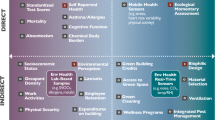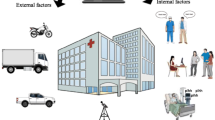Summary
In response to a request from the personnel of a credit bank that had been moved into a new building, an evaluation was made of employee health complaints. The prevalence of symptoms was determined using a self-administered questionnaire. Ventilation effectiveness, contaminant concentrations (which included chemicals and bioaerosols) and microclimate were studied to establish their relationship to environmental discomfort and to the health problems mentioned by the employees. Indoor air quality — which was assessed in different seasons — revealed relatively high levels of carbon dioxide and bioaerosols in areas occupied by employees as compared with other places. Temperature and humidity were considered to be satisfactory. Although a causative agent was not isolated, the authors conclude that an ineffective rate of room air exchange, possibly in interaction with chemical contaminants, may be responsible for the discomfort and, perhaps, for the health symptoms experienced by workers in fully enclosed rooms.
Similar content being viewed by others
References
Abbritti G, Muzi G, Colangeli C, Accattoli MP, Areni S, Betti C, Cesarini S, Fiordi T, Gabrielli AR, Marino D, Sampogna N, Felicioni D (1989) La “Sick Building Syndrome”: elevata prevalenza in un edificio di recente costruzione munito di aria condizonata (in Italian). Proceedings, 52nd Congresso Nazionale della Società Italiana di Medicina del Lavoro e Igiene Industriale, Palermo, September 28–October 1
Asbestos International Association (1979) Reference method for the determination of airborne asbestos fibre concentrations at workplaces by light microscopy (membrane filter method). AIA London
Austwick PKC (1982) Humidifier fever — a mycologist's nightmare. In: Baxter M (ed) Proceedings, Congress of the International Society of Human and Animal Mycology, London, pp 171–176
Bauleo FA, Castellani M, Gigh M, Mencarelli F, Pompei M, Baldelli G (1989) Indagine ambientale in un edificio con aria condizionata e con elevata prevalenza di “Sick Building Syndrome” (in Italian). Proceedings, 52nd Congresso Nazionale della Società Italiana di Medicina del Lavoro e Igiene Industriale, Palermo, September 28–October 1
Renard JM, McKenna TA, McKinnon DL (1986) Realting health and environmental studies in a “tight building syndrome” investigation. In: Walkinshaw DS (ed) Indoor air quality in cold climates: hazards and abatement measures. Air Pollution Control Association, Pittsburgh, pp 23–34
Berardi BM, Leoni E, GiustiM, Grillo S, Raffi GB (1986) Proposta di una metodica per la valutazione ergonomics del posto di lavoro al videoterminale (in Italian). Osp Vita 13:105–113
Berardi BM, Leoni E, Giusti M, Raffi GB (1987) Rilievi microclimatici e valutazione della carica microbica in ambienti condizionati del terziario (in Italian). Proceedings Convegno AICARR: Impiantistica nel terziario —SAIE, Bologna, October 22
Berardi BM, Giusti M, Leoni E, Cascella D, Taruffi R, Raffi GB (1988) Valutazione ergonomica del posto di lavoro al videoterminale: indagine condotta in sei aziende del terziario (in Italian). G Ital Med Lav 10:57–63
Bernstein RS, Sorensen WG, Garabrant T, Reaux C, Trietman RD (1983) Exposure to respirable, airborne Penicillium from a contaminated ventilation system: clinical, environmental and epidemiological aspects. Am Ind Hyg Assoc J 44 (3):161–169
Bertagna AN, Oleotti A, Rossi F (1989) Indagine chimica-microclimatica-microbiologica sulla qualità dell'aria in uffici (in Italian). G. Assoc Ital Ig Ind (AIDII) 14: (in press)
Blengio GS, Marini P, Perini G (1989) Il benessere microclimatico negh ambienti termici moderati (in Italian). Ig Mod 91:654–683
Burge HA, Hodgson M (1988) Health risks of indoor pollutants. ASHRAE J 30:34–36
Christensen NK, Olesen BW (1984) How to measure the thermal environment. In: Grandjean E (ed) Ergonomics and health in modern offices. Taylor and Francis, London, pp 92–99
DPCM 28 marzo 1983 N.30 — Limiti massimi di accettabilità delle concentrazioni e di esposizione relativi ad inquinanti dell'aria nell'ambiente esterno (in Italian). G.U. n° 115, 28 maggio 1983
Godish T, Rouch J, McClure D, Elrod L, Seaver C (1986) Ventilation system performance in a new classroom building assessed by measurements of carbon dioxide levels. Proceedings ASHRAE Conference IAQ '86, Managing indoor air quality for health and energy conservation, April 20–23, Atlanta, Georgia
Hedge A (1984) III—health amongst office workers: an examination of the relationship between office design and employee well-being. In: Grandjean E (ed) Ergonomics and health in modern offices. Taylor and Francis, London, pp 46–51
Miksch RR, Anthon DW, Fanning LZ, Hollowell CD, Revzan K, Glanville J (1981) Modified pararosaniline method for the determination of formaldehyde in air. Anal Chem 53:2118–2123
Morey PR, Jones WG, Clere JL, Sorensen WG (1986) Studies on sources of airborne microorganisms and on indoor air quality in a large office building. Proceedings, ASHRAE Conference IAQ '86, Managing indoor air for health and energy conservation, April 20—23, Atlanta, Georgia
Olesen BW (1985) Local thermal discomfort. Technical review. Brüel e Kjaer, Naerum, Denmark
Orpianesi C, Cresci A, La Rosa F, Saltalamacchia G, Tarsi R (1983) Valutazione dell'inquinamento microbico in un ambiente ospedaliero. Confronto tra il sistema S.A.S. (Surface Air System) e il metodo tradizionale (in Italian). Nuovi Ann Ig Microbiol 34:171–185
Pal TM, Kaufmann HF, Moncky JGR, de Vries K (1985) Lung function of workers exposed to antigens from a contaminated air-conditioning system. Int Arch Occup Environ Health 55:253–266
Riesenberg DE, Arehart-Treichel J (1986) Sick building syndrome plagues workers, dwellers. JAMA 255:3063
Robertson AS, Burge PS, Hedge A, Sims J, Gill FS, Finnegan M, Pickering CA, Dalton G (1985) Comparison of health problems related to work and environmental measurements in two buildings with different ventilation systems. BMJ 291:373–376
Roper P (1988) Hazard evaluation and technical assistance. Centre County State Health Center, State College, Pennsylvania. Report HETA 88-154-0000, Division of Surveillance, Harzard Evaluations, and Field Studies, NIOSH. U.S. Department of Health and Human Services, Cincinnati, Ohio
Simard C, Trudel M, Paquette G, Payment P (1983) Microbial investigation of the air in apartment buildings. J Hyg 91:277–286
Smid T, Schokkin E, Boleij JSH, Heederik D (1989) Enumeration of viable fungi in occupational environments: a comparison of samplers and media. Am Hyg Assoc J 50:235–239
Stolwijk JAJ (1987) The sick building syndrome. Practical control of indoor air problems. Proceedings, ASHRAE Confernce IAQ '87, May 18–20, Arlington, Virginia
Turiel I, Hollowell CD, Miksch RR, Rudy JV, Young RA (1983) The effects of reduced ventilation on indoor air quality in an office building. Atmos Environ 17:51–64
Author information
Authors and Affiliations
Rights and permissions
About this article
Cite this article
Berardi, B.M., Leonie, E., Marchesini, B. et al. Indoor climate and air quality in new offices: effects of a reduced air-exchange rate. Int. Arch Occup Environ Heath 63, 233–239 (1991). https://doi.org/10.1007/BF00386371
Received:
Accepted:
Issue Date:
DOI: https://doi.org/10.1007/BF00386371




